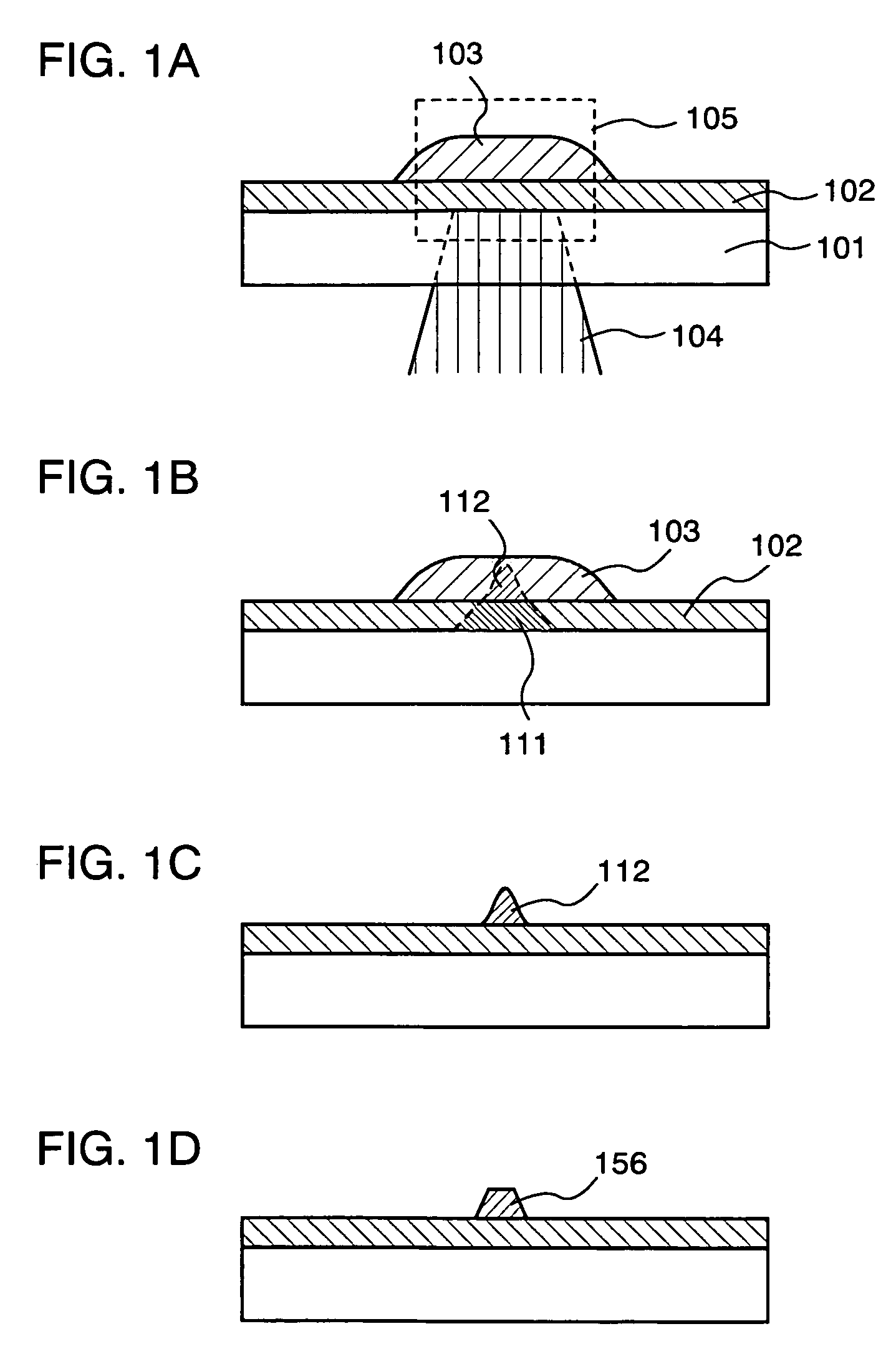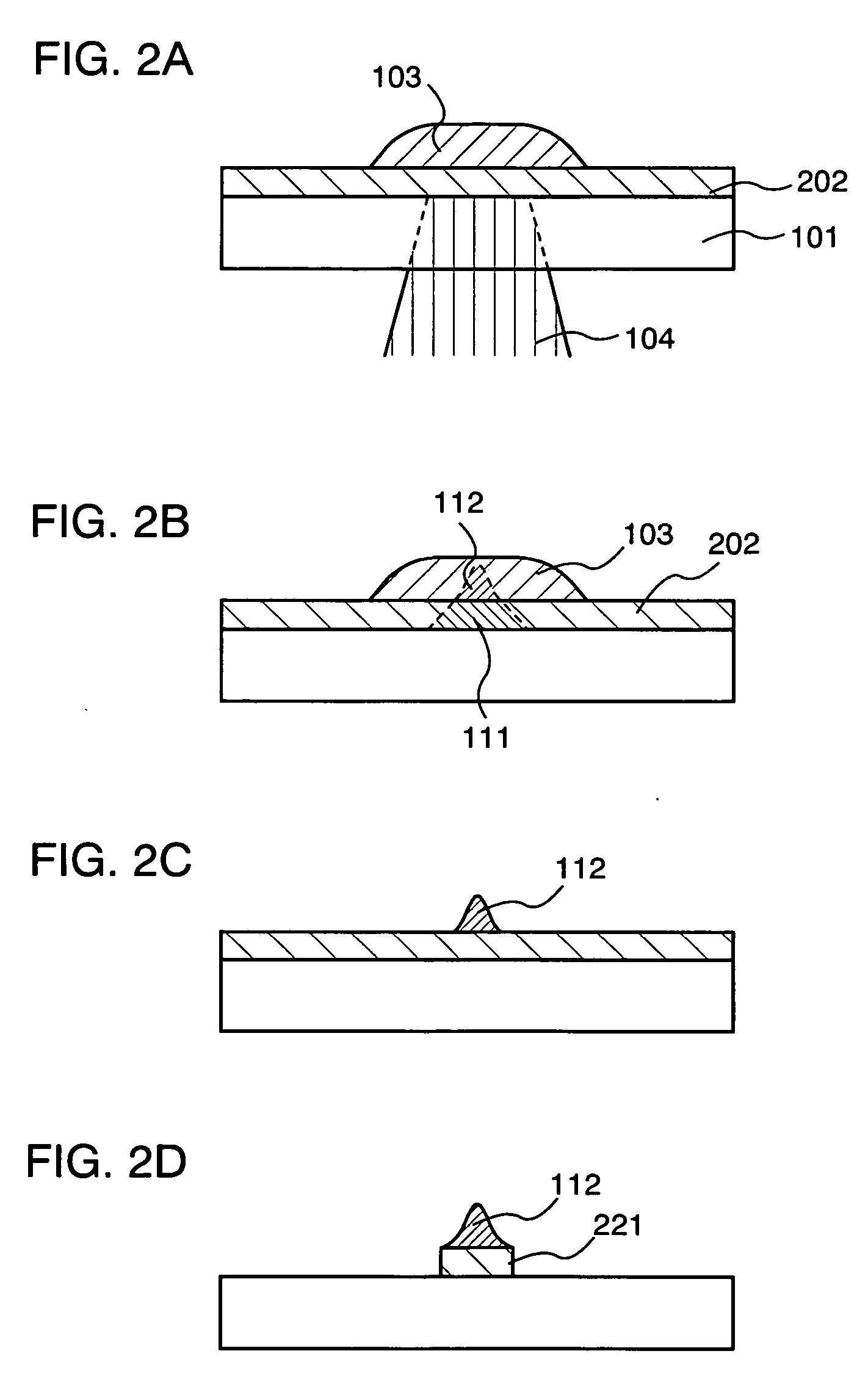Semiconductor device and method for manufacturing the same, liquid crystal television, and EL television
a semiconductor device and semiconductor technology, applied in semiconductor devices, photomechanical treatment, instruments, etc., can solve the problems of reduced yield, reduced throughput, and difficulty in executing light-exposure treatment on a large-sized substrate at once for the photolithography device used for a photolithography step, so as to enhance the usability of materials
- Summary
- Abstract
- Description
- Claims
- Application Information
AI Technical Summary
Benefits of technology
Problems solved by technology
Method used
Image
Examples
embodiment mode 1
[0092] In this embodiment mode, a step of forming a film pattern using heat energy generated by absorbing light energy of laser light in a light absorption layer is described with reference to FIGS. 1A to 1D and FIGS. 8A to 8D.
[0093] As shown in FIG. 1A, a light absorption layer 102 is formed over a substrate 101, then, a solution 103 is applied or discharged over the light absorption layer 102.
[0094] A light-transmitting substrate is used as the substrate 101. Typically, a glass substrate, a quartz substrate, a plastic substrate having heat resistance which can withstand a processing temperature of a post-step and having light-transmitting properties or the like can be used. In addition, when the substrate 101 is a glass substrate, a large-area substrate of 320 mm×400 mm, 370 mm×470 mm, 550 mm×650 mm, 600 mm×720 mm, 680 mm×880 mm, 1000 mm×1200 mm, 1100 mm×1250 mm, 1150 mm×1300 mm or the like can be used. A quartz substrate is used here as the substrate 101.
[0095] Note that, in t...
embodiment mode 2
[0138] In this embodiment mode, a method for forming a film pattern when a light absorption layer 102 is formed from a conductive material and a solution in which conductors are dissolved or dispersed in a solvent is used for a solution 103 in Embodiment Mode 1 is described with reference to FIGS. 2A to 2D.
[0139] As shown in FIGS. 2A and 2B, as well as in Embodiment Mode 1, a solution 103 is applied or discharged over a light absorption layer 202 to form a first film pattern 112 in which part of the solution is baked by heat of laser light. Here, a tungsten film is formed as the light absorption layer 202 by using a tungsten target and an argon gas with a sputtering method. A silver (Ag) paste is used as the solution 103. A conductive layer containing silver as a main component is formed as the first film pattern 112. Thereafter, the unmodified solution 103 is removed.
[0140] Next, as shown in FIG. 2C, the light absorption layer 202 is etched by using a first film pattern 112. As a...
embodiment mode 3
[0143] In this embodiment mode, a step for forming a mask pattern with laser light and forming a film pattern with the mask pattern is described with reference to FIGS. 3A to 3D.
[0144] As shown in FIG. 3A, an insulating film 301 is formed over a substrate 101 to form a light absorption layer 202 over the insulating film. The insulating film 301 is used as an etching stopper; thus, silicon oxide, silicon nitride or the like is used. A conductive film having light-shielding properties with conductivity is used as the light absorption layer 202.
[0145] Next, a solution 302 is discharged over the light absorption layer. A thermosetting material or a thermoplastic material is used as a material of the solution. Polyimide which is a thermosetting material is used here as the solution 302. Then, the light absorption layer 202 is irradiated with laser light 104 from beneath the substrate 101. As a result, as shown in FIG. 3B, a heated region 311 is formed in part of the light absorption la...
PUM
| Property | Measurement | Unit |
|---|---|---|
| wavelength | aaaaa | aaaaa |
| width | aaaaa | aaaaa |
| quantum size | aaaaa | aaaaa |
Abstract
Description
Claims
Application Information
 Login to View More
Login to View More - R&D
- Intellectual Property
- Life Sciences
- Materials
- Tech Scout
- Unparalleled Data Quality
- Higher Quality Content
- 60% Fewer Hallucinations
Browse by: Latest US Patents, China's latest patents, Technical Efficacy Thesaurus, Application Domain, Technology Topic, Popular Technical Reports.
© 2025 PatSnap. All rights reserved.Legal|Privacy policy|Modern Slavery Act Transparency Statement|Sitemap|About US| Contact US: help@patsnap.com



